Archives of Otolaryngology and Rhinology
Is there any association between Nasal Polyposis and Osteoma? A retrospective analysis of incidence of Paranasal Sinus Osteoma among 600 patients treated for Nasal Polyposis
Stefano Di Girolamo, Barbara Flora*, Francesco Maria Passali, Roberta Di Mauro, Federica Martino, Emanuela Fuccillo and Pier Giorgio Giacomini
Cite this as
Girolamo SD, Flora B, Passali FM, Mauro RD, Martino F, et al. (2019) Is there any association between Nasal Polyposis and Osteoma? A retrospective analysis of incidence of Paranasal Sinus Osteoma among 600 patients treated for Nasal Polyposis . Arch Otolaryngol Rhinol 5(2): 035-39. DOI: 10.17352/2455-1759.000093Osteoma is a rare benign lesion of the skull, with an incidence of 0.6% of all benign tumours of paranasal sinuses. It is commonly asymptomatic, and mostly diagnosed incidentally at the imaging. The most frequent disturbs are: headache, nasal discharge and symptoms of inflammation.
Osteoma is often associated with nasal polyposis and mucocele, which are usually considered as secondary lesions. Contrariwise, in our cases, we are prone to consider the osteoma as secondary to the inflammation associated with polyposis and mucocele. The physiopathology of these diseases was therefore reviewed to explain a possible relationship.
We conducted a retrospective analysis in our ENT division from January 2010 to December 2016.
In our cohort of 600 patients with nasal polyposis we found 20 cases of osteoid osteoma with an incidence of 3,33%. The mean age was 45,7 (+/-16,7 y.o.), with a Male/Female ratio of 2,3:1. In twelve cases the osteoma was located in the frontal sinus (70%), seven were implanted on the lateral part of the ethmoid roof (35%), and one extended from the ethmoidal to the frontal sinus (5%). The average tumour size was 11.04 ± 8,16 mm (range 2,88 mm– 19,2 mm). All patients underwent CT scan, clinical evaluation and ESS with histological examination.
The collected data may suggest that chronic mucosal inflammation can induces bone modification and eventually lead to osteomas.
We can hypothesize that paranasal sinus osteomas could represent a complication of nasal polyposis. Further investigations are needed to confirm this hypothesis.
Introduction
Osteomas are the most common fibro-osseous lesions of the head and neck region, affecting mainly the mandible, and represent the most frequent benign tumour of the paranasal sinuses [1], with an incidence of 0.6 % [2]. Compact osteomas are the most diffused type of osteoma found in the skull, while osteoid osteomas are rarely found in the same district. Osteomas could be found in frontal sinus, maxillary and sphenoid sinus. Frequently located in ethmoidal cells and lamina cribrosa. Posterior skull base osteomas are extremely rare [3]. The average age of onset of the disease is usually 50 years, with a ratio M/F: 2:1 [4].
These lesions origin from the bone tissue and they have the capability of synthesizing bony-like tissue.
Osteomas are generally asymptomatic and the diagnosis is often accidental, during paranasal sinus CT evaluation performed for other reasons. About 3% of all paranasal sinus CT scans show osteomas, which can be easily diagnosed because of their peculiar radiological aspect [5].
Osteomas appears like homogeneous well-circumscribed masses, with high density, attached with a narrow pedicle to the adjacent, normal bone. Osteoid osteoma can be distinguished from compact osteoma at the imaging, due to its hollow central cavity, called nidus, surrounded by a halo of reactive sclerotic bone which is distinctly visible on CT scans.
Therefore CT scan examination allows the differential diagnosis between paranasal osteoma and other fibro-osseous lesions of the skull. These lesions, which include fibrous osteoma (FO), fibrous dysplasia (FD) and ossifying fibroma (OF), may have a similar radiographic appearance, but their borders are less well-defined than those of osteoid osteoma [6].
The surgical treatment of ethmoid osteomas remains controversial. It is taken into consideration when symptoms are present or when a rapid growth leads to potential obstruction of the nasal-frontal duct, orbital and skull invasion [7].
Although various theories (embryogenetic, traumatic and inflammatory) have been developed to explain the pathogenesis of cranio-facial osteomas, it is difficult to establish a specific cause-effect relationship [8]. Because of the rarity of this tumour, we performed a retrospective study to report our experience regarding paranasal sinus osteomas synchronous with nasal polyposis. The aim was to investigate a possible correlation between these two diseases in order to better understand the physiopathology of osteomas.
Materials and Methods
We performed a retrospective analysis of the osteoid osteoma incidence in a population of 600 patients affected by nasal polyposis evaluated from 2010 to 2016. The work has been carried out in accordance with The Code of Ethics of the World Medical Association (Declaration of Helsinki) for experiments involving humans. The work obtained the approval of our Ethical commitee (with the approvation number 0004145/2018). Patient charts were retrospectively reviewed for demographics, clinical presentation and tumour extention, based on nasal endoscopy, preoperative imaging, surgical approach and follow-up. All patients were assessed preoperatively by msCT performed using a 64-multidetector CT scanner (LightSpeed VCT, GE Medical Systems), without contrast injection. Scan parameters were 80–100 kV, 100 mAs, 0.5 rotation time, 0.094 pitch. CT of the paranasal sinuses was obtained using thin-slice technique, taken in parallel to the hard palate or orbitomeatal unit. Coronal and sagittal reformats were then reconstructed to better evaluate the sinonasal anatomy. MRI was performed systematically and exclusively in case of orbital involvement or recurrent pathology.
All patients underwent dilated fundoscopy and gastroenterological evaluation in order to exclude a possible Gardner’s Syndrome.
All of the osteomas were successfully removed with no major operative complications using an endoscopic approach, that guarantees a good angle of view of the tumour and a minimally invasive technique.
In case of cribriform plate osteoma, we used intranasal drill by diamond burr and a 30°-70° endoscope.
Results and Discussion
Among the 600-endoscopic sinus surgery performed to treat chronic rhino-sinusitis associated with nasal polyps, we found 20 cases of osteoid osteoma with an incidence of 3,33%.
The mean age of patients was 45,7 (+/-16,7 y.o.), 14 males and 6 females, with a Male/Female ratio of 2,3:1.
Twelve of the tumours involved the frontal sinus (70%), seven the ethmoidal sinus (35%) and were implanted on the lateral part of the ethmoid roof, and one extended from the ethmoidal to the frontal sinus (5%). The average tumour size was 11.04 ± 8,16 mm (range 2,88 mm– 19,2 mm) (Figures 1,2)
In one case we observed the presence of nasal polyposis in the left frontal sinus and an osteoma in the contralateral one (Figure 3).
By the time of the diagnosis, all patients suffered from nasal obstruction, 14 patients presented nasal discharge (70%) and 5 had chronic headaches (25%). Only one patient, presented at the same time ethmoidal osteoma, nasal polyposis and orbital lipoma with sign of bone disruption at CT scan (Figures 4-6), complained visual disturbance, diplopia, orbital pain and headache (5%) (Table 1).
All patients underwent endoscopic sinus surgery with no major complications. Only in one case there was a cerebro-spinal fluid leakage, probably caused by the erosion of the skull base secondary to the tumor’s growth, solved easily intraoperatively with a mucosal patch. Another case showed post-operative orbital emphysema, which healed spontaneously in few days.
We evaluated our patients after 3 and 6 months from the operation, performing clinical evaluation and nasal endoscopy. CT scan was performed annually. No recurrences were reported.
The histologic examination showed a typical inflammatory pattern of nasal polyposis and “compact-ivory” type osteoma with dense, mature and compact lamellar bony tissue, leaving only few spaces for bone marrow and vessels.
Paranasal sinuses osteomas are slow-growing rare tumours, that origin mainly from the frontal sinus (70-80%). The purely ethmoidal location is less frequent (20-25%) and mainly involving the front-nasal duct area; rarely it interests the maxillary sinus (5%) and the sphenoid sinus (very rare) [9].
Osteomas are usually diagnosed incidentally during radiologic examination. The slow growth rate of osteomas explains the poor symptomatology: mainly headache or facial pain. Only 10% of cases cause symptoms, which differ depending on the location and size of the mass. The most common symptoms are headache with an incidence of 68% of the patients, followed by nasal discharge, sinusitis, pain, facial and cranial deformation [10].
Cerebral symptoms, visual disturbances, or epiphora are rare and depend on the location of the tumor [11]. Complications are due to the osteoma growth, more than 50% of the sinus volume can determine a compression or an invasion of the surrounding structures causing obstructive sinusitis, intracranial or orbital involvement with optic nerve atrophy, diplopia and limitation of ocular motility [12].
The tumour diagnosis needs imperatively CT scans that show asymptomatic or symptomatic osteomas of the paranasal sinuses as reported by Earwalker et al. [13] in 3% of 1500 scans reviewed. In some case even a MRI can help to clarify the nature and the characteristics of the lesion and to make a differential diagnosis with other fibro-osseous tumours.
The sharply defined outside margins of osteomas represent the most important radiological sign for differential diagnosis with FD (Fibrous Dyspalsia) and malignant tumours such as sarcoma or chondrosarcoma, which present with ill-defined margins. Contrast CT scan may show subtle enhancement corresponding to the soft tissues of OF (Osseous Fibroma), while osteomas are not enhanced [14].
The management of paranasal sinus osteomas is still controversial. We have to consider different parameters, first of all the clinic evaluation and the symptomatology [15].
Traditionally, resection has been performed by means of a variety of open approaches: osteoplastic flap technique with coronal incision, maxilloethmoidectomy, supraciliar approach or direct anterior surgical exposure. Although open surgical excision may be necessary in some specific conditions, there are still several points worth mentioning on account of the risk of severe complications, such as: cerebrospinal fluid fistulas, haemorrhage, damage to the surrounding structures, increased blood loss and aesthetic problems [16]. ESS (Endoscopic Sinus Surgery) has offered an alternative mini-invasive approach and has been considered to be a valuable contribution in the management of paranasal sinus osteoma. ESS offers the advantage of a closer and more direct visualization with a better surgical field, as well as avoiding damage to neighbouring structures, haemorrhage is more easily stopped and no cosmetic complications occur [17].
Several pathogenic hypotheses have been proposed: genetic theory, embryonal theory, traumatic theory and infectious theory. Genetic factors probably play an important role in the development of osteomas especially regarding Gardner’s Syndrome [18]. This is an uncommon autosomal dominant syndrome that should always be considered when we are dealing with osteomas, because it is associated with development of intestinal polyps and with a rate of malignant transformation approaching 100%. Additional features include soft tissue tumours, bone tumours, and congenital retinal pigment epithelial hypertrophy. Therefore patients with osteomas therefore deserve a dilated fundoscopy and gastroenterological evaluation [19].
The embryological theory supposes that osteoma origins from embryologic remnants or cartilaginous cells of the junctional zone, especially around the ethmoid labyrinth. It prevalently arises from suture lines between membranous (orbital part of frontal bone, lateral part of sphenoid bone, skull calvarial bone) and encondral (skull base bones) ossification areas. In these area, persistent embryologic cells rests may lead to unchecked proliferation and determine the tumourr [20].
Another etiological hypothesis is the traumatic theory that considers osteomas as a consequence of previous head injuries. This theory, on the other hand, does not explain why some lesions develop in elderly patients with no history of traumatisms.
The most exhaustive theory, even if it is still very discussed, is the infectious theory. According to it, the bone metaplasia could be secondary to a chronical infectious and inflammatory state, but it is very difficult to establish if the infection is a primary or a secondary event [21].
The infectious theory holds that osteomas are the manifestation of bony hypertrophy resulting from a chronic state of infection due to the demonstrate Th2-based eosinophilic inflammation.
Persistent Th-2 related inflammatory disorder of the breathing epithelium of the nasal and paranasal cavity is present in most subjects with either allergic or non-allergic chronic hyperplastic rhinosinusitis. These patients show an unusual association between nasal polyposis and paranasal osteoma (4% of patients with nasal sinus polyposis also have paranasal osteomas) [22]. Much more frequent is the association between osteoma and mucocele. Probably the osteoma is the first lesion and it determines the obstruction of frontal ostium causing, secondarily, the mucocele. In the cases we studied the osteoma likely represents the secondary lesion, following nasal polyposis.
Nasal polyposis can be defined as a chronic inflammatory disease of the paranasal sinus mucosa, leading to a protrusion of benign oedematous polyps from the middle meati into the nasal cavities. Nasal polyps are histologically characterized by massive oedema and accumulation of eosinophils [23]. IgE-mediated response seems to play only a minor role in eosinophil accumulation, making room for the new concept of non-allergic rhinitis with eosinophilia.
Eosinophils could play a crucial role in the inflammatory reaction, releasing almost all the known inflammatory mediators: cytokines, chemokines and growth factors.
These factors act on the narrow bone structures, stimulating osteocytes hyperplasia and that could be the mechanism that triggers the development of paranasal osteoma [8,11,12,17].
It is indeed demonstrated that nasal polyposis has effects on the morphology of the nose and sinuses, such as sinonasal bone expansion, erosion and thickening [24,25].
In polyps formation different theories are proposed. One of them is that epithelial cells lose their differentiation and morphology, polarity, and junctional attachments to one another, becoming mesenchymal cells endowed of migratory function as myofibroblasts, able to synthesize collagens and other matrix proteins, process that contribute to enlarge the size of the basement membrane [26].
Myofibroblasts tends to produce fibronectin, tenascin, and periostin as a provisional matrix to determine temporary protection of the interrupted epithelial barrier.
Those changes in mucosal tissue could related to the mass effect of the polyps themselves and could also be secondary to chronic inflammation. The remodelling of bone tissue that seems to be the primum movens to the osteoma developing.
The incidence of bone changes and osteoma masses seen in our group of patients with nasal polyposis emphasises the fact that polyposis can cause a chronic mucosal inflammatory condition that induces a bone modification and, eventually, the growth of osteomas.
Probably, considering our experience and literature, bone changes start primarly in the ethmoid sinus and then involve other regions.
The bone erosion associated with nasal polyps and their occasional resemblance to malignancy also emphasise the importance of histologically assessing all polypoid material post-operatively.
Limitation
The limit of this study is the poor numerosity of the cohort, secondary to the rarity of this type of tumour. To enforce our theory with a conclusive data we need to continue the study. It would also be interesting to add the evaluation of the modification of the bone tissue in those patients who underwent sinus surgery to treat specifically the mucocele, in order to understand if the mucocele itself could be considered as a primary phase in the growth of osteoma.
Conclusion
This study demonstrates a potential correlation between osteomas of the skull and nasal polyposis. The ethmoidal sinus seems to be the most common and primarily involved area, contrariwise the higher prevalence of osteomas affects the frontal sinus.
These data emphasise the importance of a pre-operative CT scan in assessing the severity and morphology of patient’s disease, which can help preventing intra-operatory complications involving intracranial and orbital areas. In conclusion, we hypothesize that paranasal sinus osteomas could represent a nasal polyposis complication. More studies are needed to confirm this hypothesis and prospective cohort studies are required to further examine whether bony changes related to nasal polyposis do increase the risk of developing osteomas of the skull.
Conflict of interest
This research did not receive any specific grant from funding agencies in the public, commercial, or not-for-profit sectors.
- Karatas A, Cebi IT, Yanik T, Kocak A, Selcuk T (2017) Osteoma Originating from Mastoid Cortex. Turk Otolarengoloji Arsivi/Turkish. Arch Otolaryngol 55: 48-50. Link: https://tinyurl.com/y3dv6wj9
- Mesolella M, Galli V, Testa D (2005) Inferior turbinate osteoma: a rare cause of nasal obstruction. Otolaryngol Head Neck Surg. 133: 989-991. Link: https://tinyurl.com/y26nr8ey
- Huang HM, Liu CM, Lin KN, Chen HT (2001) Giant ethmoid osteoma with orbital extension, a nasoendoscopic approach using an intranasal drill. Laryngoscope 111: 430-432. Link: https://tinyurl.com/yylmpbcl
- Janovic A, Antic S, Rakocevic Z, Djuric M (2013) Paranasal sinus osteoma: is there any association with anatomical variations? Rhinology 51: 54-60. Link: https://tinyurl.com/y4czauu9
- Engelbrecht V, Preis S, Hassler W, Lenard HG (1999) CT and MRI of congenital sinonasal ossifying fibroma. Neuroradiology 41: 526-529. Link: https://tinyurl.com/y4bvee43 .
- Sontakke SA, Karjodkar FR, Umarji HR (2011) Computed tomographic features of fibrous dysplasia of maxillofacial region. Imaging Sci Dent 41: 23-28. Link: https://tinyurl.com/yyqr2vrv
- Chahed H, Hachicha H, Bachraoui R (2016) Paranasal sinus osteomas: Diagnosis and treatment. Rev Stomatol Chir Maxillofac Chir Orale. 117: 306-310. Link: https://tinyurl.com/y3cvnmou
- Boffano P, Roccia F, Campisi P, Gallesio C (2012) Review of 43 osteomas of the craniomaxillofacial region. J Oral Maxillofac Surg 70: 1093-1095. Link: https://tinyurl.com/y5ygy8vj
- Benatiya Andaloussi I, Touiza E, Bhallil S (2006) Orbital osteoma: three case reports. Bull Soc Belge Ophtalmol 300: 73-79. Link: https://tinyurl.com/yydxo6qb
- Erdogan N, Demir U, Songu M, Ozenler NK, Uluç E, et al. (2009) A prospective study of paranasal sinus osteomas in 1,889 cases: changing patterns of localization. Laryngoscope 119: 2355-2359. Link: https://tinyurl.com/y38see59
- Moretti A, Croce A, Leone O, D’Agostino L (2004) Osteoma of maxillary sinus: case report. Acta Otorhinolaryngol Ital 24: 219-222. Link: https://tinyurl.com/y56tl8ln
- Chiu AG, Schipor I, Cohen NA, Kennedy DW, Palmer JN (2019) Surgical decisions in the management of frontal sinus osteomas. Am J Rhinol 19: 191-197. Link: https://tinyurl.com/y68rkjq7
- Earwaker J (1993) Paranasal sinus osteomas: a review of 46 cases. Skeletal Radiol 22: 417-423. Link: https://tinyurl.com/y6ko6ncm
- Ciniglio Appiani M, Verillaud B, Bresson D (2015) Ossifying fibromas of the paranasal sinuses: diagnosis and management. Acta Otorhinolaryngol Ital 35: 355-361. Link: https://tinyurl.com/y6oquo5u
- Arslan HH, Tasli H, Cebeci S, Gerek M (2017) The Management of the Paranasal Sinus Osteomas. J Craniofac Surg 28: 741-745. Link: https://tinyurl.com/y4b646ms
- Yiotakis I, Eleftheriadou A, Giotakis E, Manolopoulos L, Ferekidou E (2008) Resection of giant ethmoid osteoma with orbital and skull base extension followed by duraplasty. World J Surg Oncol 6: 110. Link: https://tinyurl.com/y3x69l73
- Lee DH, Jung SH, Yoon TM, Lee JK, Joo YE, et al. (2015) Characteristics of paranasal sinus osteoma and treatment outcomes. Acta Otolaryngol 135: 602-607. Link: https://tinyurl.com/y2ontb7h
- Koyuncu M, Belet U, Seşen T, Tanyeri Y, Simşek M (2000) Huge osteoma of the frontoethmoidal sinus with secondary brain abscess. Auris Nasus Larynx 27: 285-287. Link: https://tinyurl.com/yyuj6s2r
- Schuchardt WA, Ponsky JL (1979) Familial polyposis and Gardner’s syndrome. Surg Gynecol Obstet 148: 97-103. Link: https://tinyurl.com/yxsxx7rj
- Bachert C, Van Cauwenberge PB (1997) Inflammatory mechanisms in chronic sinusitis. Acta Otorhinolaryngol Belg 51: 209-217. Link: https://tinyurl.com/y4cujpsr
- Casado Morente J, Ayala Zeitner A, Cantillo Baños E, Jurado Ramos A (2019) Osteoma and polyposis: an unusual association. Acta Otorrinolaringol Esp 49: 491-494. Link: https://tinyurl.com/y43neg8d
- Bachert C, Zhang L, Gevaert P (2015) Current and future treatment options for adult chronic rhinosinusitis: Focus on nasal polyposis. J Allergy Clin Immunol 136: 1431-1440. Link: https://tinyurl.com/y3xx3dyt
- Schick B, Steigerwald C, el Rahman el Tahan A, Draf W (2001) The role of endonasal surgery in the management of frontoethmoidal osteomas. Rhinology 32: 66-70. Link: https://tinyurl.com/y5l8xhcz
- de Vries N (1988) New bone formation in nasal polyps. Rhinology 26: 217-219. Link: https://tinyurl.com/y4zweymm
- Rejowski JE, Caldarelli DD, Campanella RS, Penn RD (1982) Nasal Polyps Causing Bone Destruction and Blindness. Otolaryngol Neck Surg 90: 505-506. Link: https://tinyurl.com/y55hehe9
- Schleimer, Robert P (2016) Immunopathogenesis of Chronic Rhinosinusitis and Nasal Polyposis. Annual review of pathology vol 12 331-357. Link: https://tinyurl.com/y2r8embt
Article Alerts
Subscribe to our articles alerts and stay tuned.
 This work is licensed under a Creative Commons Attribution 4.0 International License.
This work is licensed under a Creative Commons Attribution 4.0 International License.
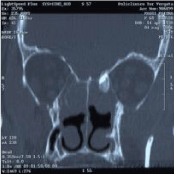
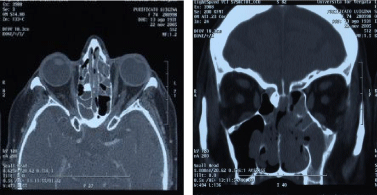
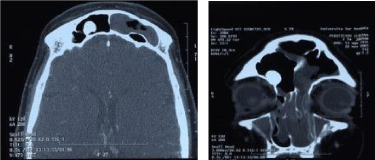
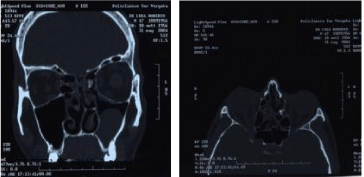

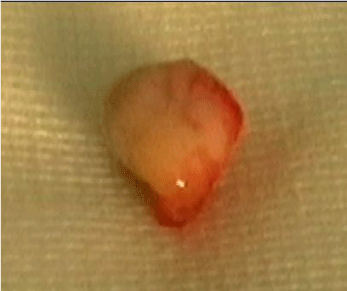
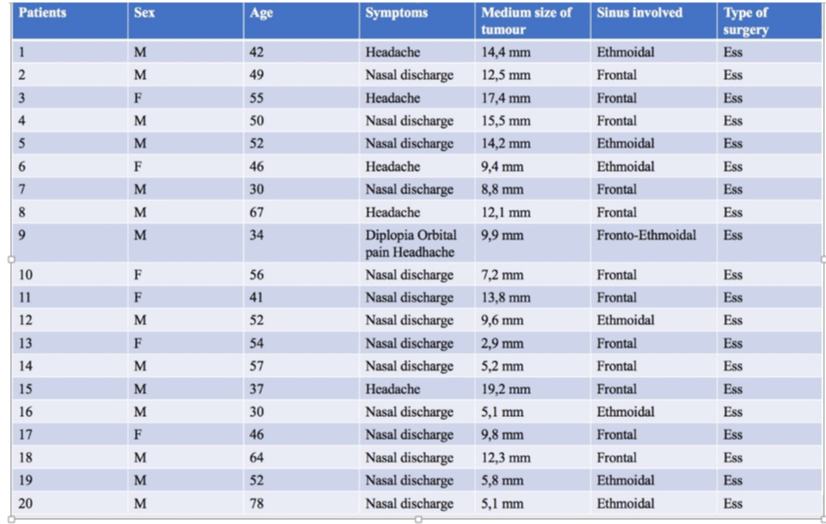

 Save to Mendeley
Save to Mendeley
